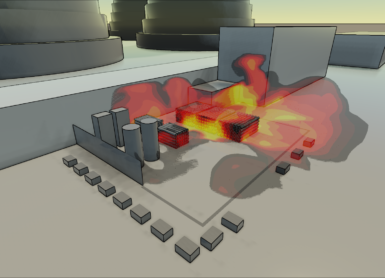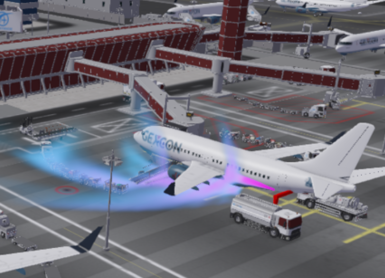
Releases of dense gases present unique challenges when it comes to consequence modelling. Unsuitable modelling may under (or over) predict the hazard ranges in urban environments, resulting in potentially increasing the risk of exposure to hazardous gases, whilst also leading to the implementation of unsuitable (or unnecessary) risk reduction measures.
Choosing the right tool, as well as understanding the limitations of your chosen tool, are equally important in properly understanding the potential consequences associated with accidental releases involving dense gases.
Importance of Geometry in Dense Gas Dispersion Modelling
Dense gases descend and spread horizontally when reaching the ground, and therefore have the potential to generate significant hazard ranges. Due to the fact that these gases move close to the ground, interaction with the surrounding environment can significantly affect the behaviour of dense gas clouds.
The topography can accelerate or inhibit the spread of dense gas clouds, and is particularly important where a facility or potential release is located in areas of complex terrain or significant changes in grade. Read more about dense gas modelling in complex terrain here. Buildings and obstacles can create areas where gas can accumulate leading to pockets of flammable or toxic concentrations. In addition to physically obstructing the spread of dense gas clouds, areas of complex geometry alter flow fields in various ways, for example:
- causing updrafts and downdrafts,
- channelling between buildings,
- areas of calm winds adjacent to strong winds, and
- horizontally and vertically rotating-eddies between buildings.
Dense Gas Dispersion Modelling Challenges
The complexity of urban areas, in particular, presents a number of challenges in determining potential hazardous extents through consequence modelling. If these challenges are not properly addressed, predicted hazard ranges may be overly conservative, thereby introducing additional costs and difficulty when implementing measures to protect potentially exposed populations. Alternatively, and more importantly, unsuitable modelling may under-predict the potential hazard ranges thus increasing the risk of exposure.
For these cases, terrain and obstacles must be modelled with high accuracy to obtain reasonable approximations of the consequences. Due to the complex terrain, dispersion around urban environments is extremely complicated, however for the same reason, it is also of utmost importance to consider topography.
Selection of Modelling Tools
Simple modelling approaches may be utilised as an initial screening, providing the user is aware that the results may only be taken as indicative. Simple tools are unable to capture both the physical effects of the obstacles and terrain as well as the impact these have on the flow fields. In order to properly capture the important effects of geometry, computational Fluid Dynamics (CFD) simulations, such as FLACS-CFD, are necessary. The potential variation between models is highlighted in an example from Gavelli[1], in which an accidental release of ammonia in an urban environment was considered.
The modelled release is consistent with the breach of a road tanker carrying anhydrous ammonia (10,000 gallons) resulting in the rapid release of its contents. The hazard footprint of such a release is predominantly dependent on the meteorological conditions (wind speed, wind direction, and atmospheric stability) and on the source conditions (here the source was modelled as a pool). For this exercise 2 wind conditions (2/F and 5/D) and 8 wind directions were considered.
Figure 1 shows the results of this study.

It is clear that the simple model provides slightly conservative results in the case of 2/F conditions, whilst also underpredicting in certain wind directions. However, for 5/D conditions the simple model significantly underpredicts the consequence of the release in all wind directions. This is due to the fact it is not able to properly capture geometrical effects such as the channelling of the flow caused by the buildings.
At Gexcon, our Consulting team has experience with a wide range of studies involving gases including biogas, natural gas, LBG, and LNG. Our X-suite software package offers a variety of tools to determine both the frequency and the consequence of hazardous scenarios. FLACS-Frequency implements state-of-the-art release, frequency models. FLACS-EFFECTS and Shell FRED offer an efficient way of modeling consequence for most release scenarios. FLACS-CFD will model consequences for release scenarios and show how consequence is affected by the surroundings.
Discover what Gexcon can do for you at our Products & Services page.
[1] Gavelli, Filippo, et al. “CFD Simulation of Gas Dispersion From Large-Scale Toxic Chemical Releases In Complex Environments.” Mary Kay O’Connor Process Safety Center, 2011 International Symposium. 201
Do you like what you read?
Get the latest trends in the field of process safety management straight to your inbox, and enhance your skills through knowledge sharing from industry experts.


